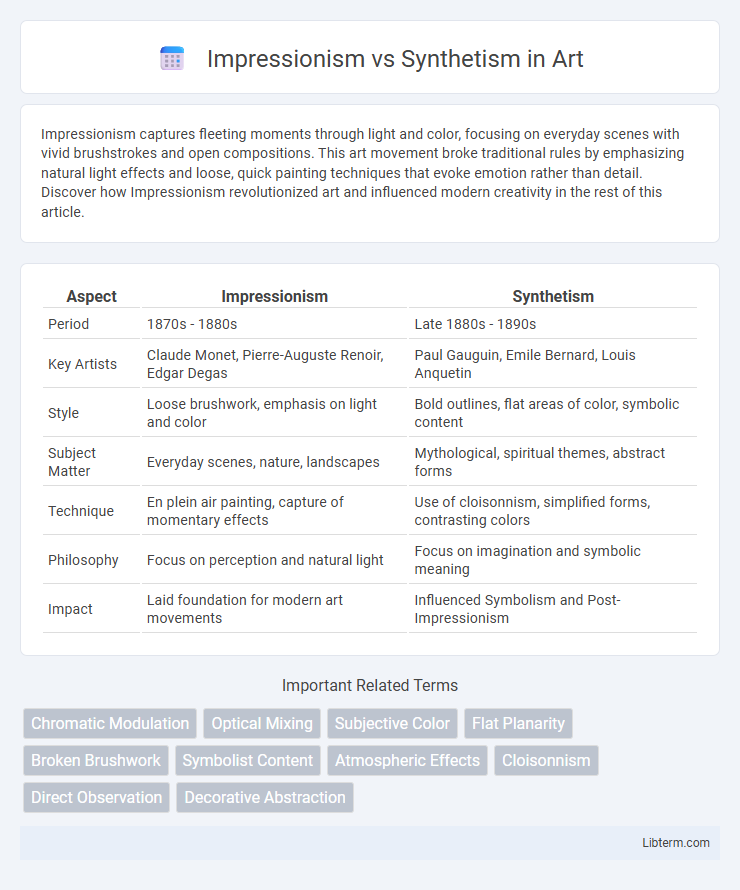Impressionism captures fleeting moments through light and color, focusing on everyday scenes with vivid brushstrokes and open compositions. This art movement broke traditional rules by emphasizing natural light effects and loose, quick painting techniques that evoke emotion rather than detail. Discover how Impressionism revolutionized art and influenced modern creativity in the rest of this article.
Table of Comparison
| Aspect | Impressionism | Synthetism |
|---|---|---|
| Period | 1870s - 1880s | Late 1880s - 1890s |
| Key Artists | Claude Monet, Pierre-Auguste Renoir, Edgar Degas | Paul Gauguin, Emile Bernard, Louis Anquetin |
| Style | Loose brushwork, emphasis on light and color | Bold outlines, flat areas of color, symbolic content |
| Subject Matter | Everyday scenes, nature, landscapes | Mythological, spiritual themes, abstract forms |
| Technique | En plein air painting, capture of momentary effects | Use of cloisonnism, simplified forms, contrasting colors |
| Philosophy | Focus on perception and natural light | Focus on imagination and symbolic meaning |
| Impact | Laid foundation for modern art movements | Influenced Symbolism and Post-Impressionism |
Introduction to Impressionism and Synthetism
Impressionism emerged in the late 19th century, characterized by artists such as Claude Monet and Pierre-Auguste Renoir who emphasized capturing light and natural scenes using rapid brushstrokes and vibrant colors. Synthetism, developed by Paul Gauguin and Emile Bernard, concentrated on combining simplified shapes, bold outlines, and symbolic colors to convey deeper emotional and spiritual meanings. Both movements challenged traditional academic art but differed in their approach: Impressionism focused on sensory perception, while Synthetism prioritized conceptual synthesis and symbolic representation.
Historical Backgrounds of Both Movements
Impressionism emerged in the 1870s in France as artists like Claude Monet and Pierre-Auguste Renoir sought to capture fleeting effects of light and color through quick brushstrokes and open compositions. Synthetism developed in the late 1880s, primarily associated with Paul Gauguin and the Pont-Aven School, emphasizing bold colors, simplified forms, and symbolic content as a reaction against the naturalism of Impressionism. Both movements significantly shaped modern art by challenging traditional techniques and exploring new expressions of perception and emotion.
Defining Characteristics of Impressionism
Impressionism is defined by its emphasis on capturing fleeting moments using loose brushwork, vibrant light effects, and natural color palettes to depict everyday scenes. Artists like Claude Monet and Pierre-Auguste Renoir prioritize spontaneous impressions over detailed realism, often painting en plein air to portray atmospheric changes. This movement contrasts with Synthetism, which employs bold contours, flat areas of color, and symbolic content, as exemplified by Paul Gauguin.
Key Elements of Synthetism
Synthetism emphasizes bold, flat areas of color, simplified forms, and symbolic content, diverging from the naturalistic light and color effects central to Impressionism. Key elements include the use of strong outlines, a focus on emotional or spiritual meaning, and a departure from realistic representation to create a more abstract and decorative aesthetic. This movement, pioneered by artists like Paul Gauguin, blends influences from Japanese prints and Cloisonnism, highlighting a synthesis of form and color to evoke deeper symbolic narratives.
Major Artists in Impressionism
Impressionism, characterized by artists like Claude Monet, Edgar Degas, and Pierre-Auguste Renoir, emphasized capturing light and natural scenes through loose brushwork and vibrant colors. In contrast, Synthetism, pioneered by Paul Gauguin and Emile Bernard, focused on bold outlines, flattened forms, and symbolic content with vivid, unnatural hues. Monet's water lilies, Degas' ballet dancers, and Renoir's social scenes epitomize Impressionism's dedication to momentary visual impressions versus Synthetism's stylized and synthesized approach.
Leading Figures in Synthetism
Synthetism emerged in the late 19th century as a reaction against Impressionism's focus on natural light, prioritizing bold colors and simplified forms instead. Leading figures in Synthetism include Paul Gauguin, Emile Bernard, and Paul Serusier, whose works emphasized symbolic content and flat planes of color. These artists sought to express deeper emotional and spiritual meanings, setting Synthetism apart with its focus on abstraction and symbolism.
Techniques and Artistic Methods Compared
Impressionism emphasizes capturing natural light and movement through quick, loose brushstrokes and a vibrant color palette to portray transient moments. Synthetism, pioneered by artists like Paul Gauguin, combines simplified forms, bold outlines, and flat areas of color to synthesize external appearance with the artist's subjective feelings. Impressionism relies on optical effects and plein air painting, whereas Synthetism integrates symbolic content and a more structured, decorative approach.
Color Theory and Use of Light
Impressionism emphasizes capturing natural light effects and atmospheric conditions through quick, broken brushstrokes and vibrant, blended colors that shift with changing daylight. Synthetism, pioneered by artists like Paul Gauguin, uses bold, flat areas of color and strong outlines to convey emotional and symbolic meanings rather than realistic light representation. The color theory in Impressionism relies on optical mixing to mimic natural light, while Synthetism adopts a more subjective, decorative palette that enhances form and emotional resonance.
Impact on Modern Art Movements
Impressionism, characterized by its emphasis on light and color through quick brushstrokes, significantly influenced modern art movements by introducing new perceptions of reality and spontaneity. Synthetism, pioneered by artists like Paul Gauguin, advanced modern art by blending symbolic content with bold colors and simplified forms, laying groundwork for Symbolism and Fauvism. Both movements challenged traditional aesthetics, fostering abstraction and emotional expression that propelled the evolution of 20th-century art.
Lasting Influence and Legacy
Impressionism revolutionized art by capturing fleeting moments with vibrant light and color, profoundly shaping modern visual perception and inspiring movements like Post-Impressionism and Abstract Expressionism. Synthetism, characterized by bold outlines and flat areas of color, influenced Symbolism and paved the way for modern graphic design and Fauvism. Both movements left enduring legacies, transforming approaches to color, composition, and emotional expression in contemporary art.
Impressionism Infographic

 libterm.com
libterm.com